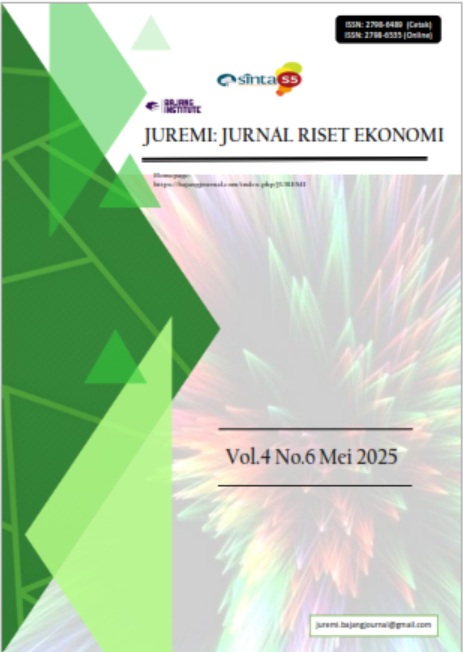DILEMA PENGGUNAAN AI: ANALISIS PERSEPSI DAN NIAT PENGGUNAAN DI KALANGAN PEGAWAI
DOI:
https://doi.org/10.53625/juremi.v4i6.10095Keywords:
artificial intelligence, continuance intention, attitudeAbstract
Penelitian ini bertujuan untuk memahami persepsi dan sikap individu terhadap Kecerdasan Buatan (AI) serta pengaruhnya terhadap niat penggunaan berkelanjutan, menggunakan metode campuran kuantitatif melalui kuesioner terhadap 100 responden pegawai pengguna AI dan kualitatif melalui wawancara mendalam terhadap 5 responden. Hasil menunjukkan hubungan linear signifikan antara sikap positif terhadap AI (GAAIS) dan niat penggunaan berkelanjutan (CI) sebesar 43%, namun ditemukan keraguan pada indikator tertentu seperti preferensi interaksi dengan manusia, keyakinan akan kemampuan AI, kekhawatiran kesalahan AI, dan ketakutan akan kontrol AI. Wawancara mengungkapkan keraguan ini disebabkan keterbatasan AI dalam memahami konteks kompleks, kurangnya kemampuan improvisasi dan penilaian moral, serta potensi bias data dan hilangnya kontrol manusia, memberikan wawasan penting tentang faktor-faktor yang mempengaruhi penerimaan AI di masyarakat.
References
R. Pakpahan, “Analisa Pengaruh Implementasi Artificial Intelligence Dalam Kehidupan Manusia,” Journal of Information System, Informatics and Computing, vol. 5, no. 2, pp. 506–513, 2021.
A. Konya and P. Nematzadeh, “Recent applications of AI to environmental disciplines: A review,” Science of The Total Environment, vol. 906, p. 167705, Jan. 2024, doi: 10.1016/j.scitotenv.2023.167705.
L. Lämmermann, P. Hofmann, and N. Urbach, “Managing artificial intelligence applications in healthcare: Promoting information processing among stakeholders,” Int J Inf Manage, vol. 75, p. 102728, Apr. 2024, doi: 10.1016/j.ijinfomgt.2023.102728.
M. G. Şahin and Y. Yıldırım, “The general attitudes towards artificial intelligence (GAAIS): A meta-analytic reliability generalization study,” International Journal of Assessment Tools in Education, vol. 11, no. 2, pp. 303–319, Jun. 2024, doi: 10.21449/ijate.1369023.
T. Vasiljeva, I. Kreituss, and I. Lulle, “Artificial Intelligence: The Attitude of the Public and Representatives of Various Industries,” Journal of Risk and Financial Management, vol. 14, no. 8, p. 339, Jul. 2021, doi: 10.3390/jrfm14080339.
I. Farid, A. H. Reksoprodjo, and S. Suhirwan, “Pemanfaatan Artificial Intelligence Dalam Pertahanan Siber,” Nusantara: Jurnal Ilmu Pengetahuan Sosial, vol. 10, no. 2, pp. 779–788, 2023.
D. Zowghi and M. Bano, “AI for all: Diversity and Inclusion in AI,” AI and Ethics, vol. 4, no. 4, pp. 873–876, Nov. 2024, doi: 10.1007/s43681-024-00485-8.
P. J. van Diest et al., “Pros and cons of artificial intelligence implementation in diagnostic pathology,” Histopathology, vol. 84, no. 6, pp. 924–934, May 2024, doi: 10.1111/his.15153.
I. Ajzen, “The theory of planned behavior,” Organ Behav Hum Decis Process, vol. 50, no. 2, pp. 179–211, Dec. 1991, doi: 10.1016/0749-5978(91)90020-T.
M. F. Sabri, N. F. Razak, E. A. Cheng Xi, and R. Wijekoon, “Going Green in the Workplace: Through the Lens of the Extended Theory of Planned Behaviour,” Pertanika Journal of Social Sciences and Humanities, vol. 30, no. 2, pp. 429–448, May 2022, doi: 10.47836/pjssh.30.2.02.
W. Rumawas, “Employees’ Turnover Intention in the Construction Industry in Indonesia,” Journal of Construction in Developing Countries, vol. 27, no. 2, pp. 127–146, 2022, doi: 10.21315/jcdc-03-21-0050.
A. Schepman and P. Rodway, “Initial validation of the general attitudes towards Artificial Intelligence Scale,” Computers in Human Behavior Reports, vol. 1, p. 100014, Jan. 2020, doi: 10.1016/j.chbr.2020.100014.
J.-P. Stein, T. Messingschlager, T. Gnambs, F. Hutmacher, and M. Appel, “Attitudes towards AI: measurement and associations with personality,” Sci Rep, vol. 14, no. 1, p. 2909, Feb. 2024, doi: 10.1038/s41598-024-53335-2.
F. Kaya, F. Aydin, A. Schepman, P. Rodway, O. Yetişensoy, and M. Demir Kaya, “The Roles of Personality Traits, AI Anxiety, and Demographic Factors in Attitudes toward Artificial Intelligence,” Int J Hum Comput Interact, vol. 40, no. 2, pp. 497–514, Jan. 2024, doi: 10.1080/10447318.2022.2151730.
Khemiko Khemiko, Yoke Pribadi Kornarius, Angela Caroline, Triningtyas Elisabeth Putri Gusti, and Agus Gunawan, “Pengaruh Sikap Generasi Milenial dan Generasi Z terhadap Kecenderungan untuk Terus Menggunakan Teknologi Kecerdasan Buatan,” EKONOMIKA45 : Jurnal Ilmiah Manajemen, Ekonomi Bisnis, Kewirausahaan, vol. 12, no. 1, pp. 338–353, Dec. 2024, doi: 10.30640/ekonomika45.v12i1.3567.
G. L. Susanto, A. Caroline, Y. P. Kornarius, T. E. P. Gusti, and A. Gunawan, “Sikap dan Niat Terhadap AI: Studi Perbandingan Generasi Berdasarkan Perilaku Terencana,” eCo-Buss, vol. 7, no. 2, pp. 1115–1129, Dec. 2024, doi: 10.32877/eb.v7i2.1614.
A. Bhattacherjee, “Understanding Information Systems Continuance: An Expectation-Confirmation Model,” MIS Quarterly, vol. 25, no. 3, p. 351, Sep. 2001, doi: 10.2307/3250921.
J. Hohenstein et al., “Artificial intelligence in communication impacts language and social relationships,” Sci Rep, vol. 13, no. 1, p. 5487, Apr. 2023, doi: 10.1038/s41598-023-30938-9.
V. M. Fedorets, O. V Klochko, I. A. Tverdokhlib, and O. A. Sharyhin, “Cognitive aspects of interaction in the ‘Human — Artificial Intelligence’ system,” J Phys Conf Ser, vol. 2871, no. 1, p. 012023, Oct. 2024, doi: 10.1088/1742-6596/2871/1/012023.
Z. Chen, “Privacy Protection Technology in the Age of A.I.,” IOP Conf Ser Mater Sci Eng, vol. 750, no. 1, p. 012103, Feb. 2020, doi: 10.1088/1757-899X/750/1/012103.
















